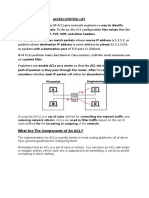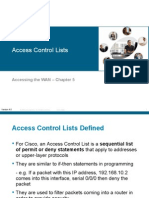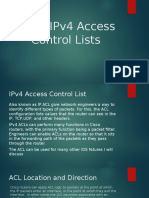0% found this document useful (0 votes)
42 views2 pagesACL Notes
The document outlines the use of Access Control Lists (ACLs) in network management, emphasizing their role in controlling packet transmission and access to devices like routers. It details the creation and application of ACLs, distinguishing between inbound and outbound rules, and explains the differences between standard and extended ACLs. Additionally, it highlights the importance of proper configuration to avoid blocking all traffic and the efficiency of applying ACLs inbound on interfaces.
Uploaded by
shuvoCopyright
© © All Rights Reserved
We take content rights seriously. If you suspect this is your content, claim it here.
Available Formats
Download as PDF, TXT or read online on Scribd
0% found this document useful (0 votes)
42 views2 pagesACL Notes
The document outlines the use of Access Control Lists (ACLs) in network management, emphasizing their role in controlling packet transmission and access to devices like routers. It details the creation and application of ACLs, distinguishing between inbound and outbound rules, and explains the differences between standard and extended ACLs. Additionally, it highlights the importance of proper configuration to avoid blocking all traffic and the efficiency of applying ACLs inbound on interfaces.
Uploaded by
shuvoCopyright
© © All Rights Reserved
We take content rights seriously. If you suspect this is your content, claim it here.
Available Formats
Download as PDF, TXT or read online on Scribd
/ 2






























































